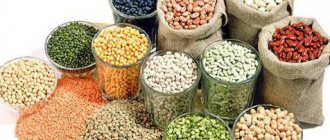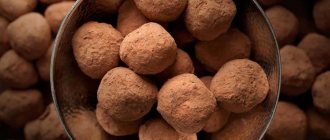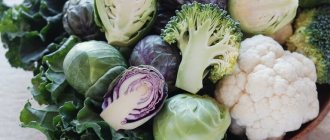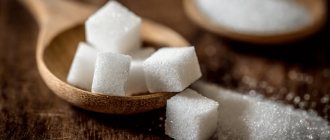Sweets entered the daily human diet not so long ago. Just four centuries ago, no one knew about profiteroles, cakes and ice cream. But once people tried the delicacies, they could no longer refuse them.
Today, desserts are an integral part of every person's menu. And even the threat of weight gain or skin problems does not stop cake lovers. However, there is good news: there are healthy sweets that will not harm your figure and health.
Nutritionists have calculated the daily allowable amount of sweets for people of normal weight. This is either 3 slices of chocolate, or a teaspoon of honey, or half a kilogram of fresh sweet fruit. You should not forbid yourself from tasty treats, but simply consume them in moderation. Below we present the healthiest sweets that you can treat yourself to without harming your health.
Summer temptation: what sweets will not harm your figure?
Sweet cravings are one of the strongest reasons that force us to break our diet or give up trying to switch to a balanced diet. Even stars are no strangers to earthly weaknesses: sweets are the secret love of Taylor Swift, Rihanna, Heidi Klum, Jennifer Garner, Jessica Alba, Ashlee Simpson, Karolina Kurkova and many other famous beauties. “Carbohydrates are the enemies of your figure, especially eaten in the afternoon,” Rihanna shares her slimming secrets, “but if I don’t eat sweets for three days, I feel unhappy. Therefore, on the advice of my trainer, I eat desserts only in the morning, after breakfast, and in small portions. And I allow myself flour and fatty foods – muffins, cream pies and cakes – as rarely as I can restrain myself.”
We invite you to prepare your body for summer with pleasure - without breakdowns or remorse! Olga Perevalova, a nutritionist at the Rimmarita clinic, will help us choose the ten healthiest sweets that do not harm our figure: “Treats for those with a sweet tooth are the number one topic. How useful or useless are these same treats for a healthy diet? All food is made up of calories, and calories come from proteins, fats and carbohydrates. Fatty calories and carbohydrates make you fat if you eat a lot of them at once (more than 300 g). That's why desserts exist to be savored, not to be stuffed. Treats are eaten after the main meal and little by little - this is the main rule for everyone who controls weight. Of course, you should eat sweets in the first half of the day, before 15–16. This also applies to sweet fruits. They will have time to assimilate and will not be put off.”
Fruits and berries: a definite “yes”!
The number one summer dessert - fruits and berries - contains many vitamins, minerals, organic acids, essential oils, fiber and other beneficial substances necessary for our health and beauty. It is better to enjoy the gifts of summer fresh, as well as by preparing dessert soups and salads, juices, fruit drinks, smoothies and cocktails from them, preferably without adding sugar and fatty dairy products. Some of the beneficial properties of berries and fruits are retained by homemade five-minute jam, but it is better to puree them with sugar without cooking, dry or freeze them.
Olga Perevalova: “As for jam, it is certainly healthy, since it is made from natural berries, with soul, with the warm hands of a mother or grandmother. Eat and praise! Especially in winter, in cold weather... But we always remember the dosage rule, both in winter and in summer: one teaspoon of delicacy contains from 20 to 40 kcal, depending on how much sugar is added, so it is not recommended to eat more than two teaspoons of jam a day.”
Daily intake of fruits and berries: at least 400 g
Calories (per 100 g): strawberries - 36 kcal, strawberries - 48 kcal, raspberries - 44 kcal, black currants (red) - 44 kcal, apricots - 49 kcal, cherries - 52 kcal, homemade jam - 200-300 kcal
Dried fruits: a definite “yes”!
Raisins, prunes, dried apricots, dried apples, pears and other dried fruits are a dessert long known to mankind and one of the most recommended healthy snacks by modern nutritionists. Dried fruits are a “concentrate” of vitamins, minerals and other beneficial substances. This delicacy normalizes metabolism and the functioning of the cardiovascular system, removes toxins from the body, promotes excess weight loss, and improves skin condition. It is better to rinse dried fruits with warm water rather than boiling water to preserve vitamins.
Olga Perevalova: “Dried fruits are one of the best healthy treats. Natural product, vitamins, pectins, fiber, antioxidants, fructose bioflavonoids... Very healthy, but also high in calories, so when pampering yourself with dried apricots, prunes, raisins, we keep it in moderation.”
Daily intake of dried fruits: about 30 g
Calorie content (per 100 g): dried apricots – 240 kcal, raisins – 250 kcal, apple – 255 kcal, pear – 213 kcal, prunes – 222 kcal
Candied fruits: remember the sense of proportion
Candied fruits are prepared from fruits, berries, sweet vegetables (pumpkin, carrots, beets, turnips), boiled in sugar syrup and dried in the oven, citrus peels, and nuts. Distant “relatives” of dried fruits are criticized by some nutritionists for their high sugar content, but all experts are unanimous that candied fruits for dessert are still better than cookies or candies. In addition, candied fruits are rich in beta-carotene, vitamins A, PP, B1, B2, C, magnesium, potassium, phosphorus, iron and fiber. The delicacy tones the nervous system: improves memory, increases performance and self-control. Avoid bright candied fruits - chemical dyes are used in their production.
Daily intake of candied fruits: about 30 g
Calorie content (per 100 g): 216–231 kcal depending on the original product
Honey: a definite yes!
Honey is the oldest delicacy and medicine known to man. In terms of calories, honey is equal to sugar, but significantly surpasses it in benefits. Honey is recommended for weakened immunity, as well as during intense physical activity as a natural energy source.
Honey is rich in vitamins B, PP, C, essential oils, organic acids, natural sugars - fructose and glucose, bioflavonoids-antioxidants, enzymes and minerals (magnesium, manganese, iron, potassium, calcium, sulfur, chlorine, sodium, etc.) .
For those who do not like honey or are prone to allergies to this product, you can try adding natural maple syrup to your diet - it contains a lot of potassium, calcium, iron and healthy sugar - dextrose.
Olga Perevalova: “An alternative to sugar is honey. But natural, not fake. Sugar is just pure carbohydrate calories and nothing useful. Not a single vitamin, mineral, much less protein - only glucose! And it is very necessary, but rarely. Honey is another matter. The calories are the same (1 teaspoon has about 40 kcal, like sugar), but how much benefit! Microelements, vitamins, bioflavonoids, antioxidants... And the smell! And the taste!!! Weight watchers should take no more than 1 teaspoon per day. And remember that overeating honey is also dangerous because it is an allergen.”
Daily honey intake: 50–80 (100) g
Calorie content (per 100 g): 320–415 kcal depending on the type of peduncle
Dark chocolate: remember the sense of proportion
Love the right chocolate - dark (black) or bitter - and you will be happy in the form of excellent health and a beautiful figure. Sometimes both of these types are considered one for a high content of cocoa products (at least 55%), sometimes they are diluted, noting that dark chocolate does not contain milk fats and sugar.
High-quality chocolate is an excellent antidepressant (a source of the “happiness hormone” serotonin), an aphrodisiac, a storehouse of antioxidants, flavonoids, vitamins and minerals that are beneficial for the heart and blood vessels.
Vegetable cocoa protein is useful because it does not contain cholesterol, is slowly absorbed and, therefore, satiates longer. The substance tannin in chocolate regulates the functioning of the digestive system and promotes detox.
Olga Perevalova: “Chocolate is the leader among healthy sweets in terms of protein content, but it is not the protein of chocolate that makes you fat, but cocoa butter, of which chocolate contains from 35 to 50%, as well as carbohydrate calories from sugars, dried fruits, liquor and other fillers, hence the extra weight. So, chocolate, but dark! It contains a lot of valuable vegetable protein, potassium, calcium, magnesium, phosphorus, iron, B vitamins, PP, lecithin, which is necessary for active mental work. So let’s enjoy chocolate, but in moderation!”
Daily value: 20–30 g
Calorie content (per 100 g): 550–650 kcal
Pastila: remember the sense of proportion
Pastila is an old Russian delicacy, the recipe for which was solved by French confectioners in the 19th century and modified into marshmallows. Both desserts are made from a whipped mixture of fruit and berry puree with sugar and egg white, only the pastille contains less sugar, proteins and a gelling agent - agar. Marshmallow, due to its high pectin content, promotes detoxification of the body, strengthens blood vessels, hair and nails. Perhaps the most difficult thing is to find real marshmallows in the store, and not its “chemical” analogue.
Daily value: 30 g
Calorie content (per 100 g): 300 kcal
Zephyr: remember the sense of proportion
Marshmallow is a “relative” not only of marshmallows, but also of marmalade due to the presence of a natural gelling component - pectin (it is obtained from apples, citrus peels, watermelons, sugar beets). Desserts based on pectin should be present in the diet of city residents, as this substance binds and removes heavy metal salts and radionuclides from the body.
There are no vitamins in marshmallows (they are destroyed during heat treatment of raw materials), but there are no fats either, and the proteins in its composition strengthen muscle tissue. This delicacy also contains iron and phosphorus. Choosing marshmallows without icing, fillers or dyes will help you avoid extra calories.
Daily value: 30 g
Calorie content (per 100 g): 300 kcal
Marmalade: remember the sense of proportion
Marmalade is produced with the addition of pectin, gelatin or agar-agar (this is a plant analogue of gelatin). Marmalade, like marshmallows and marshmallows, does not contain fat. When buying marmalade, it is a good idea to study its composition indicated on the label so as not to purchase a product with an abundance of “chemicals”.
Homemade options for replacing marmalade are jelly or jelly, made not from store-bought concentrates, but from natural freshly squeezed juices with gelatin or starch.
Olga Perevalova: “We can say about marmalade, marshmallows and marshmallows that these delicacies do not contain fats, vitamins, and have very few microelements. And all calories come from carbohydrates and sugars. Carbohydrates will burn quickly and will not be deposited on the waist if you do not eat these sweets in batches: one or two pieces with tea after the main meal once or twice a week is enough.”
Daily intake of marshmallows, marshmallows and marmalade: 30 g
Calorie content (per 100 g): 300 kcal
Halva: be careful, sweet temptation!
Halva is a favorite oriental sweet all over the world. It is incredibly tasty and healthy, easy to digest. This is a source of complete vegetable proteins and fats (which by definition do not contain cholesterol), polyunsaturated fatty acids, as well as minerals: potassium, magnesium, phosphorus, iron. Halva is rich in vitamins A, E and group B, which improve skin condition, strengthen the cardiovascular system, rejuvenate the body and activate reproductive function.
The calorie content of the delicacy is high, so you shouldn’t treat yourself to halva too often.
Daily intake of halva: 20–30 g
Calorie content (per 100 g): 500–570 kcal
Ice cream: beware, sweet temptation!
The most popular cool summer dessert is, of course, ice cream. Even Madonna, who now promotes a strict macrobiotic diet and prohibits children from eating “harmful” delicacies, lost weight on ice cream in her youth. The fattest and most nutritious variety is ice cream, but 200 g of this dessert without fillers (chocolate, nuts, cookies, etc.) contains the daily requirement of minerals and trace elements for an adult. The lowest calorie type of ice cream is popsicles. This is what Demi Moore adores when freezing freshly squeezed cherry or grapefruit juice.
Olga Perevalova: “I would not recommend going on mono-diets, including sweet ones - ice cream, chocolate, etc., since you are obviously limiting yourself in a variety of essential microelements and vitamins by consuming only one product. Everything should be in moderation!”
Daily intake of ice cream: 60–100 g
Calorie content (per 100 g): ice cream – 227 kcal, cream – 183 kcal, milk – 126 kcal, fruit and berry – 110.8 kcal, fruit ice – 68–71 kcal
Photo: Splashnews/Alloverpress.ru, Shutterstock.com
Harmful sweets
No. 1. Sugar
Sugar is 100% carbohydrate calories, pure glucose, 374 kcal per 100 g. Not a single vitamin, no minerals, not a trace of protein.
No. 2. Candy caramel
Candy caramel - 96% carbohydrate calories, 362 kcal per 100 g. No vitamins or microelements.
No. 3. Cola and other carbonated drinks
Cola - 100% carbohydrate calories, 1500 kcal 1.5 liter bottle. Nothing useful.
No. 4. Cakes
Even if the package of the cake bears the “low-calorie” label, don’t believe your eyes, it’s unlikely to contain less than 300 kcal per 100 grams. Secondly, margarine is used in confectionery production. Rarely anyone in Russia dares to call it by its real name - trans fats. Are you ready to risk not only your figure, but also your health?
Conclusion : it is better to eat healthy food for this amount of calories, which contains proteins, healthy carbohydrates from vegetables and fruits, bread, cereals, natural berries, juices, vegetable oil, than to absorb “naked” calories. This, in the end, is simply dangerous to health, as it increases the risk of developing diabetes.
General rules
- Sweets should be eaten in the first half of the day before 15-16. This also applies to sweet fruits.
- Treats should be eaten after the main meal so as not to provoke spikes in blood sugar. Otherwise, we will get not only a surge and then a rapid drop in mood, but also increased production of the hormone insulin, which is responsible for storing fat.
Tricky tricks for eating less sweets
- “Cool” your favorite chocolate, put it in the freezer and eat, or rather, bite, cold.
- Cut the candy with a sharp knife into 8, or better yet, 16 pieces. Eat mindfully, enjoying every moment.
- Add cinnamon and vanilla to your drinks and dishes. These spices reduce cravings for sweets
- Eat sweets consciously, not at night under the cover of darkness and do not suffer from guilt after eating. Enjoy!
- Focus solely on the process itself. A treat is already a pleasure; you don’t need to “combine” it with watching TV, hanging out with friends or reading a book.
- Treat your family, friends, colleagues and friends generously.
Chocolate
Nutritionists are constantly debating whether chocolate is a dietary product. And we can say with confidence: yes and again yes, of course. With one amendment: if you don’t overdo it and eat a couple of pieces of dark chocolate a day. By following these two rules, you will see that chocolate will not give you extra grams, but will have a positive effect on your body. Dark chocolate prolongs youth and effectively fights age-related skin changes. And a slice of chocolate improves your mood and gives you a boost of energy for a long time.
For chocolate to be fully healthy and “correct”, it should not contain sugar (its minimum content is permissible). The ideal option is 95% cocoa and 5% sugar. Today you can even find dark chocolate completely without sugar (with stevia, for example).
Unfortunately, finding high-quality chocolate is not so easy, but there is a way out: you can always make it yourself. For this we need cocoa powder, milk powder, sugar, water and butter. Make syrup from water and sugar, add dry ingredients and quickly mix everything. Add butter, stir everything well - and the chocolate is ready! Cool it a little, pour it into molds, and put it in the refrigerator. As a culinary experiment, butter can be known as coconut butter or ghee.
To make real dark dark chocolate, take butter, cocoa powder and a little sugar. The chocolate will have a rich taste and a noble bitter aftertaste. Melt the butter in a water bath, then add sugar and stir until the sugar is completely dissolved. Then you need to add cocoa, mix everything, pour the chocolate mixture into molds and into the refrigerator. Everything is unrealistically simple. Enjoy!
Marmalade
Marmalade is a delicacy that consists of 90% pectins extracted from fruits. This sweet can be found in any store in at least 10 variations, but it’s still better to make it yourself. Unfortunately, often the marmalade sold in supermarkets has absolutely nothing in common with a real jelly delicacy.
For example, making homemade raspberry marmalade is as easy as shelling pears. It turns out mega tasty and without thickeners, dyes and other “chemicals”. All you need for this are raspberries (however, you can take any berries you like), sugar and a few tablespoons of water. Boil the berries until they become soft, cool and grind through a sieve. Add sugar and water to the puree and cook over low heat for 30-40 minutes. Pour into molds, cool and place in the refrigerator to harden. When serving, roll in sugar or powdered sugar.
Fruit marmalade is no less tasty than berry marmalade, and lemon and ginger jellies will really appeal to citrus fruit lovers. The taste of the marmalade is very bright, sweet and sour, with a spicy, burning note of ginger... and the smell is just crazy (in the good sense of the word)!
So, in order to make this marmalade, you will need lemon, a piece of ginger, brown sugar, water, a little vanilla and a tablespoon of natural thickener - agar-agar. Peel the lemon and ginger and chop finely. Mix sugar with water until it is completely dissolved, add lemon and ginger, boil for a couple of minutes after boiling. Add vanilla, strain through a sieve and mix with agar-agar. Judge, pour into molds and into the refrigerator. Ready!
Marshmallow
Perhaps marshmallows are the undisputed leader on the “nutritionist approved” list. The good news is that there is not an ounce of fat in marshmallows. The bad news is that the store-bought one contains too much sugar. What to do? Either eat it in limited quantities (like everything, even healthy sweets), or cook it at home. We offer an excellent recipe for making homemade marshmallows.
And if you adhere to a protein diet, prepare marshmallows according to Dukan. For this you will need gelatin, low-fat cottage cheese, skim milk and a sweetener. A detailed recipe for making homemade marshmallows according to Dukan is here.
Flax seeds
Main source of Omega-3, lecithin and fiber. And this:
- perfect skin, hair and nails;
- normal weight;
- improved digestion;
- healthy immunity;
- strong bones.
They are most often used in their pure form, adding whole seeds or grinding them into any dish, including as a dessert.
Homemade halva recipe
An arbitrary amount of seeds must be crushed, preferably using a coffee grinder, and diluted with a little water. Mix the mixture thoroughly with honey in a 2:1 ratio. The prepared paste with a nutty flavor will be an excellent addition to tea, coffee and other drinks. You can diversify the halva with dried fruits.
Sweets "Happiness". In a deep bowl, mix half a glass of raisins (steam them first), one glass of flax seeds, fried in a dry frying pan and ground, and 1 tbsp. l. rolled oats, soaked for 5 minutes in 1 teaspoon of hot water. Add half a glass of honey to the mixture and place in a bag. After this, roll it out into a layer and place it in the refrigerator. After 2 hours, having cut the finished dish into squares, you can enjoy a healthy and tasty dessert.
Cocoa beans. Eating chocolate and losing weight - is it possible? Yes, if it is made from cocoa nuts. The fact is that they tone the entire body, accelerating metabolic processes. In addition, these nuts are rich in vitamins, give you a great mood and give you strength. Therefore, despite their high calorie content, they will only bring benefits.
Cocoa recipe “Slimness”
- Separate the grains from the peel and grind.
- Mix with cinnamon and honey.
- Pour hot milk or water over all ingredients and enjoy the aromatic drink.
Homemade chocolate recipe
- Finely chop 50 g of cocoa beans (without husks) and sift through a sieve.
- Melt cocoa butter (50 g) and add the resulting powder and honey.
- You can add pineapple pieces, cinnamon, and ginger to taste.
- Pour into molds and cool.
Carob (powder from carob pods). It is a full-fledged cocoa substitute due to its similar aroma and color, but has a lower calorie content (about 260 Kcal). Unlike chocolate beans, it:
- contains practically no fat;
- sweet in taste (i.e. there is no need to add sugar and honey to dishes with it);
- rich in fiber;
- rejuvenates the body.
Used in the same way as cocoa powder. You can use the previous recipes for cocoa beans, excluding honey.
Thus, even if you adhere to strict rules of proper nutrition, you can always pamper your body not only with tasty foods, but also try to prepare healthy sweets.
Bye everyone. Best regards, Vyacheslav.
Sweets that don't affect your figure
In addition to vegetables and fruits, there are a number of foods that do not affect a person’s weight. You can eat them safely, but in moderation. The main ones:
- Honey
– easily replaces sugar, can be added to drinks or cereals. Consumption does not cause excess weight, and just 1 spoon can suppress the desire to eat a bar or candy.
- Black chocolate
– we are talking about bitter varieties. When choosing, you need cocoa to be 70% or more. In this case, there will be no consequences for the body. The product helps reduce the likelihood of tumors and is also beneficial for the functioning of the heart and blood vessels.
- Marmalade
– a high-calorie product, but completely safe for the body. It allows you to cleanse the body of waste and toxins, normalizes cholesterol, and contains no harmful fats.
- Marshmallow
– you need to eat without fillers, chocolate, etc. The main part of the composition is protein, which everyone needs. Marshmallow is a low-calorie sweet.
- Oriental sweets
– easily satisfy hunger, healthy because they do not contain refined sugar (honey, nuts and dried fruits).
- Ice cream
– buy only those that use skim milk. Do not consume versions with fillings or chocolate. The safest type is fruit ice; it is better to prepare it at home using fresh juice.
- Jelly
– an excellent dessert that improves digestion. The product is low-calorie, but possible harm can only be reduced in situations if the composition contains natural ingredients.
On a diet, you can eat dried fruits in the form of dates, raisins or dried apricots. They are sweet and healthy, contain a lot of calories, and it will be difficult to consume more than 30-50 g.
There are so many options for desserts and other treats that won't harm your body. In this case, you need to follow a simple rule - moderation.











